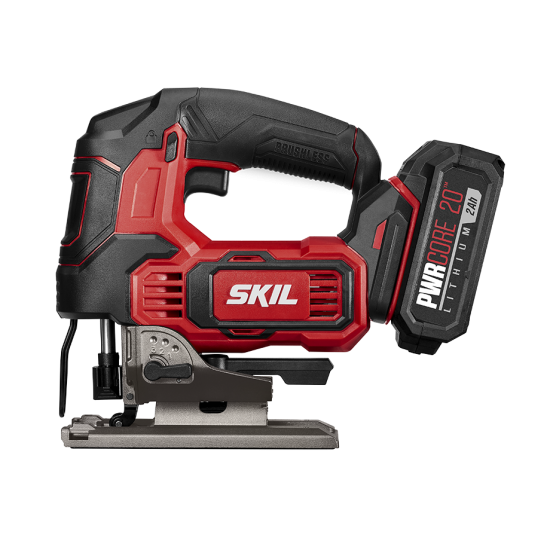We’ll compare the six most popular jig saws to determine which is the best cordless jig saw for your shop. In the end, two saws lead the pack. One leads in performance while the other leads in value.

Jig saws are some of the most versatile tools in the shop. They are best suited for curves or other free-hand cuts. The reciprocating (up-and-down) blades can cut wood, metal, plastic, drywall, fiberglass, and everything in between. In short, jig saw are the only handheld power tool that can cut curves.
They can cut straight lines as well. That’s largely dependent upon the steadiness of your hand or a straight-edge guide that you’re cutting against.
You need a jig saw for curves. You also need a jig saw for quick cuts that don’t need to be dead accurate but need to be fast. Jig saws can make cross cuts (cutting a board in half), rip cuts (cutting a board down the middle), or curved cuts. One jig saw can cut may different materials; the only thing that has to change is the blade.
Jig saw blade packs usually come with a variety of blades for different cuts and materials. Thinner blades are better for curves and wider blades are better for straight lines. Coarse-toothed blades are better for wood while fine-toothed blades handle metal better.
Jig saws also benefit from their portability. Instead of having to bring your work to the tool, you can bring your tool to the work. This is helpful for large or unwieldy pieces that are difficult to move or are already installed.
They can make pretty much any cut, but they will be rough cuts. Jig saws are popular due to their versatility. While dead straight cuts would require a circular saw or table saw, a decently straight cut can be achieved with a jig saw.
In short, yes. Longer answer, it depends.
Power is rated a little differently between cordless and corded saws.
Three things determine the cutting capacity of a cordless jig saw: battery size, stroke length, and blade speed. Battery size will determine run time of a cordless tool. The other two metrics (stroke length and blade speed) are comparable between modern corded and cordless jig saws.
The Quick Answer
Pick the MILWAUKEE 2737 for maximum power and features at a reasonable price.
The SKIL JS820202 is the value play in this comparison. It’s a capable saw at a compelling price.
MAKITA XVJ02Z
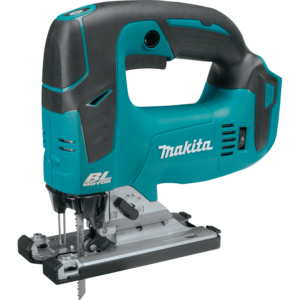


MAKITA’s XVJ02Z brings a bunch to the table. There’s a lot of electrical wizardry in this jigsaw relative to the rest of the field. However, it’s a bit polarizing.
Some love it. Others don’t.
This unit is a little heavier than most and has a very high blade speed at 3,500 spm.
Four orbital settings will allow for varying degrees of cutting aggressiveness. Blade speed is controlled by a 6-speed dial located at the base of the unit.
LED lights are included but a blower is not. This is a bit disappointing since most of the competition includes this feature.
Keyless blade changes keep things simple. The beveling function does require a hex key to lock and unlock, which is a departure from the keyless norm.
The polarizing bits of this saw are found in its safety features. Some will welcome them; others will find them intrusive. We’ll summarize them and let you decide.
The XVJ02Z features a no-load speed reduction. When under no load (i.e. before you start cutting and the blade is cutting air) the saw will always start at the lowest speed. Once the blade hits resistance (wood), it will begin speeding up to your desired speed on the dial. If you stop and restart a cut, you’ll restart at a slow speed until the saw decides to ramp up to the dial’s speed.
Cuts requiring conservative accuracy will welcome this feature. If you want to attack cuts with the full speed available in a saw, this feature will frustrate you.
The next safety measure that MAKITA included in the XVJ02Z is a lock switch on top of the tool. When the tool is turned on, this button must be pressed before cutting. Pressing the button turns the tool into ‘ready’ mode and the tool can start cutting. If you wait for 10 seconds or more, the tool goes dormant and you must press the button again to start cutting.
It’s an extra step. If your workflow includes multiple 10+ second pauses in quick succession, this feature might slow you down.
All in all, the XVJ02Z brings plenty of power and capability to the table. However, we feel that MAKITA burdened this jig saw’s agility with too many training wheels for most woodworkers.
MILWAUKEE 2731
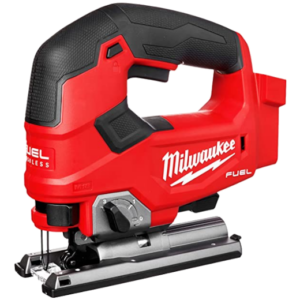
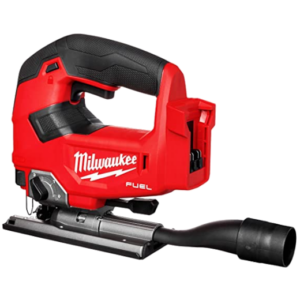
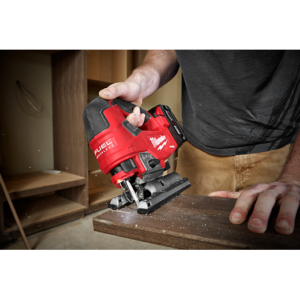
MILWAUKEE brings the 2737 with a bunch of power and features. It has all that we like to see in a cordless jigsaw.
At 5 lbs and 3,500 spm, the 2737 is as fast as they come at a slightly above-average weight. We like to see a little bit of heft in jig saws since they have to fight against jumping up from the workpiece.
Four orbital settings let us dial in cut aggressiveness as well as any other saw. Blade speed is controlled by a variable speed trigger. We find this to be the most intuitive form of speed control.
Dust control shines in the 2737 with multiple options for keeping dust to a minimum. The included dust blower can send dust forward or backward, depending on your preference. The forward-facing option keeps the cutline clear for maximum cutting visibility. The backward-facing option can send dust and chips into the integrated dust chute. The included dust port can attach to your shop vac or dust collection system to keep your workspace air clean.
The standard LED worklight keeps things brightly lit for maximum visibility.
Bevel adjustments are tool-free and easily managed with a lever located towards the back of the tool body. Positive detents ensure confident angle adjustments.
Blade changes are accomplished with a lever-action blade change mechanism.
The 2737 lives up to MILWAUKEE’s reputation. It accomplished its job well and kept our workflow efficient.
RYOBI P524
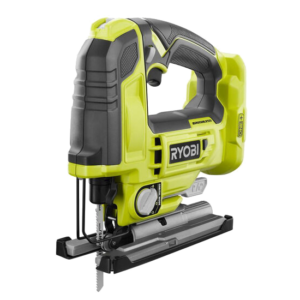
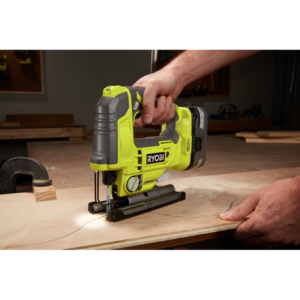
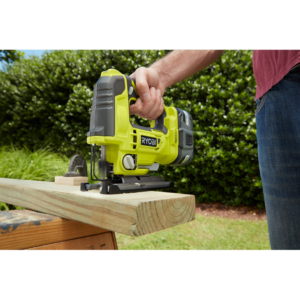
The P524 is a solid entry from RYOBI in this comparison. Typically seen as a budget option for power tools, RYOBI continues to improve and solidify itself as a line that punches with the rest of the bunch while remaining affordable.
This jig saw is no exception.
It weighs around four and half pounds, which is average. The 3,350 spm is above average and will cut metal and wood with ease (provided it’s equipped with the appropriate blade).
The P524 includes a blower and an LED light, so workflows are well-illuminated and cut lines are kept mostly free of dust.
The beveling base includes a couple of common detents for quick and accurate adjustments when making beveled cuts. Typically, we like to use circular saws for beveled cuts but the RYOBI will do in a pinch. Also, the base is locked and unlocked with a quick release lever so adjustments can be made without any extra tools like hex keys.
The RYOBI features four orbital settings for a variety of cut aggressiveness. Remember, these settings should only be engaged in soft materials. Keep the orbital setting off for harder materials like metal.
A tool-less blade clamp mechanism allows for quick blade changes and the eject feature helps prevent the need to touch a hot blade after a cut is made.
The P524 includes all the features we like to see in a cordless jig saw. It’s a very capable addition to the expansive ONE+ cordless system from RYOBI.
BOSCH JSH180
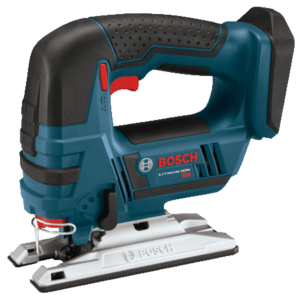

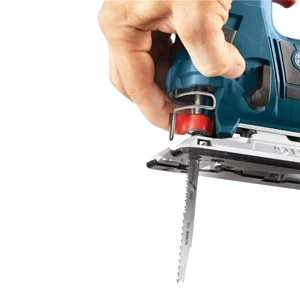
BOSCH’s JSH180 represents the most seasoned saw model in this comparison. It’s a reliable unit that could use a refresh with the latest tech. Nevertheless, it’ll cut anything you throw at it and is a solid expansion of the 18V cordless line from BOSCH.
This is the only brushed motor of the bunch. Brushless motors are increasingly common with their decreased maintenence requirements so the JSH180 might need a brush replacement after a few years of heavy use.
At 2,700 spm, the BOSCH is among the slower saws reviewed here. For tougher materials like metal, that won’t matter. The difference would be seen in cutting speeds for softer materials like softwoods.
The variable speed trigger included in this saw is intuitive and only rely on heavier or lighter presses to variate the blade speed.
A blower and LED light are included, which is impressive considering the JSH180’s age. BOSCH was a bit ahead of its time here.
The beveling base adjusts to all the normal degrees, but it does require a hex key. We wish a tool-less design was incorporated into the JSH180.
At 4.1 lbs, the BOSCH is very light compared to the rest of the competition. This is a double-sided coin since the lighter weight alleviates arm fatigue. However, lighter saws can be less stable in tough cutting environments.
The JSH180 is overdue for a refresh with modern features. That said, it’s still a workhorse that’ll perform as needed in most situations.
SKIL JS820202

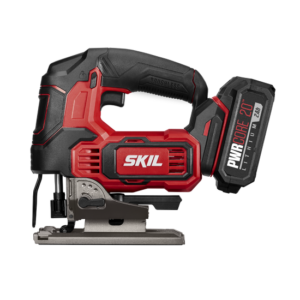
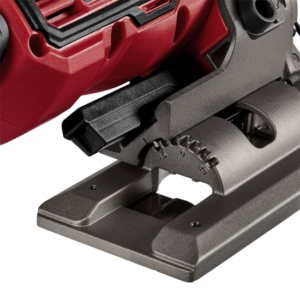
SKIL’s reinvention of itself continues with the JS820202. It’s an affordable jigsaw that is moderately-powered. It’s aimed at the weekend warrior and it performs well in a variety of tasks.
One of the compelling features of this jig saw (and other products in the PWR CORE line of tools) is that it comes with everything you need to get started. Most of the competition only includes the bare tool; batteries and chargers are sold separately. Not SKIL. Most of their tools come with batteries and chargers included (the JS820202 included).
Its weight is average at 4.7 lbs but it is a little slower that the rest of the pack at 3,000 spm. These slower speeds can be offset by selecting more aggressive orbital settings on this saw.
Blade speeds are controlled with a variable speed trigger. It’s simple and natural; we prefer this style of variable speed functionality and we think you will too.
Bevel cuts are straightforward with an adjustable base that’s locked and unlocked with a release lever on the back of the saw. Common angle detents are included for rapid adjustments.
A unique capability of the SKIL is its compatibility with both t-shank and u-shank blades. Other saws only accept one or the other, but the JS820202 can use either style of jig saw blade.
A blower and LED light are included. The blower can be turned off with a switch on the side of the saw. We like to keep it on but it’s nice to have the optionality.
The JS820202 is an affordable unit that will serve the occasional DIYer well but is also capable enough for a more serious woodworker. It also comes with an industry-leading 5-year warranty. It says a lot when a manufacturer stands behind its tools like SKIL.
DEWALT DCS334

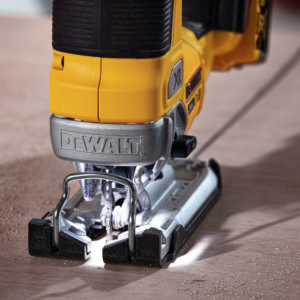

Rounding out the last of the units we’re comparing is certainly not the least of the bunch. DEWALT’s DCS334 is a workhorse. It’ll do all you ask and is a noteworthy addition to the 20V MAX line of tools from the trusted brand.
Speed and weight are both average at 3,200 spm and 4 lbs. The 1″ stroke is standard and provides satisfactory cutting capacity when equipped with an appropriate blade.
The DCS334 felt very comfortable in our hands. It didn’t seem too tall or unwieldy.
This jig saw has more variable speed adjustments than the rest of the competition. A speed control dial sets the max speed and a variable trigger lets the user ramp up from 0 to whatever max speed is set on the dial. It takes a little of the guesswork out of blade speed.
A forward-facing latch releases the blade. It also unlocks the blade clamp (i.e. the latch must be released for both installing and removing a blade).
The tool-free bevel adjustment is a welcome addition along with positive detents all the way to 45 degrees, left and right.
An LED worklight and dust blower are included. While blowers typically blow forwards, the DCS334 can send the dust backwards with the optional dust shroud (sold separately). Furthermore, a universal dust port connector can send dust from the shroud to your shop vac.
There’s a lot to like and really no complaints with the DCS334. It’s a reliable and capable jig saw that will serve woodworkers of all degrees well.
So Which Jig Saw Is Best?
We’ve summarized the strengths and weaknesses of each jig saw above. We’ll continue to pit them against each other below to determine which is the best cordless jig saw for your workshop. Beyond these summaries, full reviews for each tool can be found here:
- MAKITA XVJ02Z (Full Review)
- MILWAUKEE 2737 (Full Review)
- RYOBI P524 (Full Review)
- BOSCH JSH180 (Full Review)
- SKIL JSH820202 (Full Review)
- DEWALT DCS334 (Full Review)
Scoring will be based on each jig saw’s performance in three categories. Also, units can score equally if deserved in a particular category (e.g. a first, second, third, etc isn’t forced). For this comparison, the max score possible is set at 100 and the minimum score is 30.
Which Cordless Jig Saw is the Most Powerful?
Exemplary = 30 points
Satisfactory = 20 points
Below Average = 10 points
Power in cordless tools is largely determined by battery size. Capability is another factor but all six saws have roughly the same stroke length so cutting capacity isn’t a deciding factor.
Battery size (in amp-hours, or Ah) varies by manufacturer.
At the top of the list is DEWALT, MILWAUKEE and BOSCH. Each line includes batteries up to 12.0 Ah. These batteries are beasts and can last for a while under the most strenuous conditions before requiring a recharge.
In the middle of the pack is RYOBI. With a max battery charge of 9.0 Ah, the ONE+ line will suffice for any jobs within normal constraints.
At the low end is SKIL and MAKITA. These two manufacturers only offer batteries up to 6.0 Ah. To be clear, this will do fine for a few dozen wood cuts, but be prepared for recharge breaks if you’ll be cutting metal for an extended period of time. For these two models, we’d recommend an extra battery in the rotation so your workflow isn’t interrupted.
DEWALT, MILWAUKEE, and BOSCH earn 30 points. RYOBI earns 20 points. SKIL and MAKITA earn 10 points.
Which Jig Saw has the Most Features?
Exemplary = 40 points
Satisfactory = 25 points
Below Average = 10 points
The arms race among cordless jig saws heats up when comparing features.
At the front of the pack are SKIL and MILWAUKEE. The SKIL comes with tool, battery, and charger (along with a USB charging accessory for reviving phones and tablets) and can accept both types of jig saw blades. MILWAUKEE’s dust collection capabilities are unmatched; it alson includes all of the other features like tool-less adjustments, LED lights, and variable speed functionality.
In the middle of the bunch are RYOBI and DEWALT. Both include a blower, LED light, and tool-less bevel adjustments and blade changes. Both saws incorporate features that are becoming increasingly standard and expected.
We wish the BOSCH was more refreshed for this comparison. The brushed motor and lack of tool-less bevel adustments are a bit behind the times.
The MAKITA is a strange case. It actually has a lot of features; we just didn’t find any of them useful. The over-abundance of safety features got in the way of our workflows.
SKIL and MILWAUKEE earn 40 points. RYOBI and DEWALT earn 25 points. BOSCH and MAKITA earn 10 points.
Which Cordless Jig Saw is the Most Affordable?
Exemplary = 30 points
Satisfactory = 20 points
Below Average = 10 points
RYOBI and BOSCH are among the cheapest (in price) in this group. The SKIL is slightly more expensive but remember it comes with a battery and charger.
MILWAUKEE and DEWALT are priced about average for this comparison set.
MAKITA brings a considerable jump in price relative to the rest of the jig saws in this review.
RYOBI, BOSCH, and SKIL earn 30 points. MILWAUKEE and DEWALT earn 20 points. MAKITA earns 10 points.
Final Results
MILWAUKEE’s feature-laden 2737 takes our top recommendation for the best cordless jig saw you can buy. With it’s heavy arsenal of available batteries and solid construction, it’s a win on all fronts.
Close behind is our recommendation for the best value – the SKIL JS820202. We were really impressed by its capability in such an affordable package.
RYOBI, DEWALT, and BOSCH all offer quality units with different strengths. Each of these are worthy expansions of your toolchest if you’ve already committed to any of their respective tool lines.
The MAKITA XVJ02Z is a frequent flier on the struggle bus. Until some glaring issues are resolved, we recommend steering clear of this jig saw.


